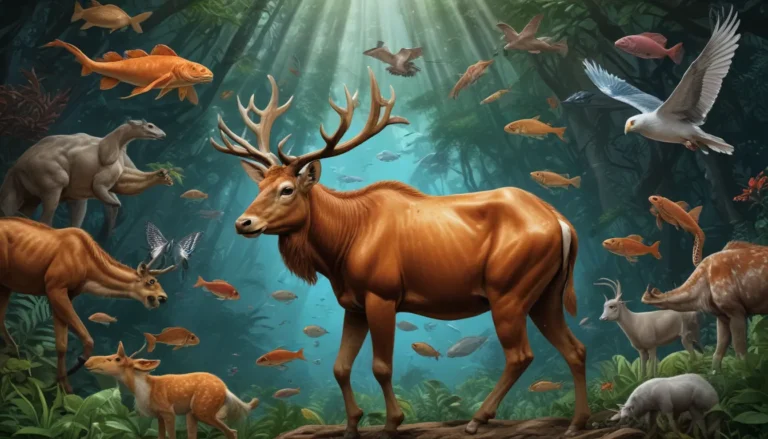A Note About Images: The images used in our articles are for illustration purposes only and may not exactly match the content. They are meant to engage readers, but the text should be relied upon for accurate information.
Are you intrigued by the mesmerizing power of waves? Waves are not just simple ripples in the ocean; they hold incredible energy, travel vast distances, and create stunning natural wonders across the globe. From giant walls of water to the soothing sound of crashing waves, these natural phenomena connect us to the beauty of the world around us. Join us on a journey to uncover 11 intriguing facts about waves that will deepen your appreciation for the wonders of nature.
The Magic of Ocean Waves
The vast oceans that cover our planet are home to countless waves of various shapes and sizes. From gentle ripples to massive swells, waves are created by energy transfer from the wind, seismic activity, or even the gravitational pull of the moon. These undulating wonders continuously shape our coastlines and provide endless fascination for surfers, scientists, and beachgoers alike.
Waves: Travelers of the Sea
While we often associate waves with the crashing surf on the shore, these incredible forces of nature can travel vast distances across oceans. Some waves can journey from one side of the globe to the other, carrying vital information about our planet’s climate and tectonic activity. The energy behind these waves is a testament to the extraordinary power of nature.
The Symphony of Sound Waves
Waves are not limited to the ocean’s surface; they can also manifest in the form of sound. Sound waves travel through various mediums, including air and water. The speed of sound is much faster in water than in air, making it an efficient method of communication for marine animals. The songs of whales and the clicks of dolphins create mesmerizing underwater symphonies that highlight the beauty of acoustic waves.
Giant Walls of Water: Awe-Inspiring Beauty
From towering walls of water to massive swells, some waves can reach heights exceeding 100 feet. These colossal waves, known as “big waves” or “rogue waves,” attract daring surfers from around the world. The complex oceanic phenomena that create these giants are both exhilarating and dangerous for those who seek to ride them.
The Electromagnetic Spectrum: A Diverse Range of Waves
The electromagnetic spectrum encompasses a wide range of waves, from radio waves to gamma rays. Each segment of this spectrum has its unique properties and uses. Radio waves are essential for communication, while X-rays are vital for medical imaging. This diverse array of waves showcases the versatility and power of these natural phenomena.
The Science of Wave Measurement
Scientists have developed sophisticated methods to measure and analyze waves. From height and frequency to speed and direction, numerous parameters help quantify and understand waves better. Specialized instruments like wave buoys and radar systems collect data to provide insights into wave behavior. These measurements are crucial for predicting tides, analyzing coastal erosion, and designing offshore structures.
Riding the Waves: The Surfing Culture
Surfing is a sport centered around harnessing the energy of waves. Surfers, or wave riders, seek out the perfect wave to challenge themselves and experience the thrill of riding its energy. The surfing culture has its language, rituals, and competitions that revolve around the power and beauty of waves. Surfers share a deep respect for the ocean and its waves, forming a tight-knit community bonded by their love for the sea.
The Transmission of Energy Through Waves
Waves are not only visually captivating but also essential for transmitting energy. From radio waves carrying signals through the air to light waves enabling vision, waves play a crucial role in various aspects of our lives. The ability of waves to transmit energy underpins many technological advancements that shape our modern world.
The Devastating Power of Tsunamis
Tsunamis are among the most destructive and powerful waves on Earth, often triggered by undersea earthquakes, volcanic eruptions, or asteroid impacts. These massive sea waves can travel vast distances and wreak havoc when they reach shorelines. The sheer force and destructive potential of tsunamis serve as a stark reminder of nature’s awe-inspiring power.
The Creation of Natural Wonders
Waves have the remarkable ability to sculpt and create breathtaking natural wonders. The constant action of waves against coastal cliffs can carve out magnificent sea caves, stunning arches, and towering stacks. These geological formations stand as a testament to the transformative force of waves and the ongoing interaction between land and sea.
Waves: Connecting Us to Nature’s Beauty
Whether we’re listening to the soothing sound of waves lapping at the shore or witnessing the raw power of a stormy ocean, waves deepen our connection to the natural world. They remind us of the vastness and beauty of our planet, inviting us to immerse ourselves in its wonders. The rhythmic ebb and flow of waves evoke feelings of peace, serenity, and awe, connecting us to something greater than ourselves.
In Conclusion
In conclusion, waves are captivating natural phenomena that shape our world in profound ways. Understanding the intricacies of waves not only enhances our appreciation for the beauty of our planet but also drives technological advancements across various fields. Whether you’re intrigued by the physics of wave propagation or simply fascinated by the power of a crashing wave, exploring the world of waves is sure to enlighten and captivate you. Take a moment to appreciate the incredible phenomenon of waves that surrounds us, shaping our world and deepening our connection to nature’s wonders.
FAQs About Waves
- What are waves?
-
Waves are disturbances that transfer energy without transferring matter, manifesting in various forms like water waves, sound waves, or light waves.
-
How do waves form in the ocean?
-
Ocean waves are primarily formed by the wind blowing across the water’s surface, transferring energy and creating ripples that develop into larger waves.
-
What is the wavelength of a wave?
-
The wavelength of a wave is the distance between two consecutive points in phase, such as two crests or two troughs, measured in meters.
-
What are electromagnetic waves?
-
Electromagnetic waves consist of electric and magnetic fields oscillating perpendicular to each other, including radio waves, microwaves, visible light, and more.
-
Can waves be used for communication?
-
Yes, waves are commonly used for communication, with radio waves for broadcasting and light waves for fiber-optic communication systems.
-
How are waves measured?
-
Waves are measured by parameters like amplitude, frequency, and wavelength, using specialized instruments to collect data for analysis.
-
Are all waves visible to the human eye?
-
No, invisible waves like infrared and ultraviolet exist in the electromagnetic spectrum beyond the visible light spectrum.
-
Can waves be destructive?
-
Yes, waves can be both constructive and destructive, shaping coastlines through erosion and causing damage during storms or tsunamis.
-
How fast do waves travel?
-
The speed of waves varies depending on the medium, with sound waves traveling slower through air and faster through water.
-
Can waves interfere with each other?
-
Waves can interfere with each other, resulting in constructive or destructive interference when two waves meet.
-
What is the Doppler effect?
- The Doppler effect is the change in frequency or wavelength of a wave observed by an observer in motion relative to the source, such as the changing pitch of an ambulance siren.
Explore the World of Waves
Delve deeper into the mesmerizing world of waves to unlock the secrets of nature’s phenomena. From the soothing sound of crashing waves to the awe-inspiring power of tsunamis, waves captivate us with their beauty and energy. Connect with the natural world around you, and let the wonders of waves inspire and enlighten you on your journey through Earth’s captivating landscapes.






